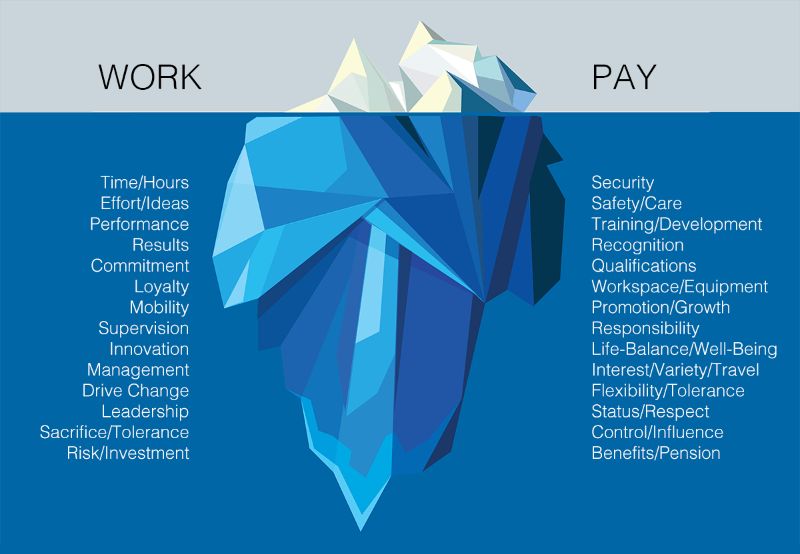The Psychological Contract: Why Employers Need to Live Up to Their Promises

The role of a strong corporate brand is clear in driving recruitment interest, shaping expectations and influencing the attractiveness of a certain employer. However, what we often find the need to reiterate with our clients is the necessity of follow through, and ensuring that your employer brand lines up with the true reality of your organization.
The term ‘psychological contract’ was first used in the early 1960s. It refers to the unwritten parts of the ‘deal’ that the organization is establishing when they take on a new employee. Some of them might be ‘promises’ and others may be ‘expectations,’ but ultimately, the employee believes that they’re part of an agreement with their employer (Guest & Conway, 2002).
The psychological contract iceberg model illustrates this employee-employer relationship. While certain elements may be clearly agreed upon (the work the employee is hired to do and the amount that the employer will pay) there are still many underlying expectations on both sides of the equation. A job seeker’s perception of your company is a consequence of both their experience with your company, and any information they’ve received along the way. In practice, the employer brand essentially “defines” this psychological contract with employees.

The goal in having a strong employer brand is obviously to attract and retain talent, but what happens if the employer’s brand is building up expectations that they can’t follow through on?
Bottom line, organizations can’t risk making promises they do not intend to stand by. If the main “hook” your organization uses to recruit talent is exceptional training and development, you better ensure that you truly have a culture of continuous learning and real opportunities. Similarly, sharing stories of work/life balance and flexibility may draw people in, but if the real-life experience is a 60-hour workweek and a rigid schedule, employees will clue in fast. A less-than-authentic brand causes your organization to lose credibility, which can actually be more damaging than not making the promise in the first place.
There are a few reasons that this ‘alignment’ is extremely important to your recruitment efforts:
Attraction: Aim to Hire the “Right Fit”
Painting an accurate picture of your organization ensures you’re drawing in the right people who are naturally going to align with your company’s values.
Engagement: Honesty Really is the Best Policy
No employer is perfect, and job seekers are well aware of that fact. Employees are more willing to compromise if you cannot check off all the boxes on their dream job checklist, but more critical of inaccurate information or having the feeling they’ve been mislead.
If your organization is honest, employees are going to be much more forgiving and even more comfortable with organizational change. Focus on where you want to be as an organization, but don’t pull any punches about the current situation. Were the results of your recent employee engagement survey really bad? Instead of trying to spin the results to seem more positive, own up to your current reality, figure out how to improve, and then openly share your game plan with the organization.
Retention: A-Players have Options
If your organization doesn’t portray itself accurately and draws candidates in who, in time, will see a misalignment between the situation they expected and the reality they’re facing, an organization’s retention rate is going to suffer. A-Players have options, and you won’t be attracting the best and brightest for very long if you’re trying to be something you’re not.
By ensuring you not only have a strong employer brand, but also making sure it’s accurate, you’ll be able to attract the right people, engage the talent you currently have on board, and make sure that they’re in it for the long haul.
